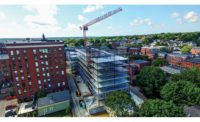New England’s construction industry was fortunate to have a sizable backlog of turnkey projects ready to be built as soon as the recession ended, including several luxury condo towers in Boston. And the market for high-end residential properties only grew as the economy continued to improve.
But in the time since the recession ended, there’s been a slight movement in market sectors from residential to institutional and higher education markets, says Gilbane Building Co.’s Ryan Hutchins. “If you look back at every cycle we’ve been through in the past 50 years,” says the senior vice president overseeing New England, “it always starts out as a big residential play and then shifts into this institutional-based market sector. I see that throughout New England.”
Results from ENR New England’s first-ever Top Contractors survey support Hutchins’ outlook. Based on 2015 revenue, the education sector alone generated $1.5 billion in work compared with $836.8 million in multi-unit residential projects during the same span. Health care brought in another $760.4 million.
|
View Complete List of New England's 2016 Top Contractors Main Ranking |
The 19 participating firms in the first annual ranking reported revenue totaling $6.28 billion in the region—which includes Connecticut, Maine, Massachusetts, New Hampshire, Rhode Island and Vermont. The top five firms collected a combined $4.04 billion.
Head of the Class
No other firm in the survey showed more promise in the education sector than Consigli Construction Co. With $393.66 million worth of work, the Milton, Mass.-based firm is building a number of projects in academia, including a 12,000-sq-ft addition to the music hall at Phillips Exeter Academy in New Hampshire, a five-story addition to Harvard’s Gore Hall and a 78,000-sq-ft addition to the Williams College science center.
The top-ranked firm was Suffolk Construction, which performed $169.95 million worth of work in the education sector in 2015. Suffolk is currently building an 86,000-sq-ft “mass timber” building at the University of Massachusetts Amherst. The wood-concrete composite structure features cross-laminated timber (CLT).
Another big education project under construction in New England is the $88-million engineering building at Brown University. One of the first education projects in the region to employ an integrated project delivery contract, the engineering building will include specialized facilities for nanoscale and biomedical engineering along with two full floors of new lab space designed to expand cross-disciplinary research. The project is being built by Shawmut Design and Construction, ENR New England’s first-ever Contractor of the Year (see story p. 18).
Shawmut also built the $100-million Bruce C. Bolling Municipal Building for the headquarters of the Boston Public Schools in Dudley Square. BPS hopes to build its first new school in more than a decade a few blocks away from the 215,000-sq-ft Bolling Building. Being built by Gilbane and partner Janey Construction Management, the $70-million Dearborn STEM Academy will be completed by 2018. The science/technology/engineering and mathematics (STEM) school will feature flexible spaces for collaboration, open spaces designed for project-based learning as well as learning commons.
The region’s institutional sector has been spurred by a plethora of new biopharmaceutical products. Gilbane recently broke ground on a 200,000-sq-ft manufacturing plant in Norton, Mass., for Alnylam Pharmaceuticals. The plant will house approximately 150 new full-time employees.
Finding Talent
New England is fertile ground for pharmaceutical talent, but the local construction industry still struggles to find and retain employees after a mass exodus of workers during the recession. “There’s a talent shortage both professionally and in the trades that affects productivity,” says Anthony Consigli, CEO at Consigli Construction. “But we’re well prepared to handle that and do not stretch ourselves too thin by being careful on how many projects we commit to building.”
Hutchins said efforts to attract and retain the best workers will continue as “the pipeline that we look at that looks out six to 18 months shows a steady handful of opportunities coming toward us.”







Post a comment to this article
Report Abusive Comment